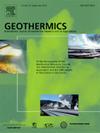“隐藏”的热液技术潜力和技术经济学:用更多的数据揭示渗透率和流体
IF 3.9
2区 工程技术
Q3 ENERGY & FUELS
引用次数: 0
摘要
历史上对热液的估计很大程度上依赖于对温度或热流的估计,而忽略了对自然流动流体的需要。更准确的热液估计需要一些渗透率和地下自然存在的流体的指示。本文描述了一种新的方法,利用相对丰富的大盆地数据,在热液估计中包括渗透率和流体的代理。具体来说,在极端梯度增强(XGBoost)回归中,使用了正在运行的地热发电厂的铭牌容量(兆瓦)、负(0兆瓦)位置和48个地球物理和地质特征来进行热液容量预测。此外,本工作将基于xgboost的热液预测输入到可再生能源潜力(reV)模型中,以量化技术能力、不确定性和技术经济。与历史上的热液估计相比,这些预测符合37个正在运行的地热发电厂和负位置。我们提出了一种利用地质领域知识按比例表示负极的方法,对负站点进行子采样,使标签达到平衡。总的来说,热液技术能力和现场平准化能源成本的分布分别比以前对大盆地的估计更紧密、更低和更准确,因为它们包括渗透率和流体的地质和地球物理替代值。百分位(50和90,分别是中位数和高估计值)模型为这些指标提供了终点。本文章由计算机程序翻译,如有差异,请以英文原文为准。
"Hidden" hydrothermal technical potential & technoeconomics: Revealing permeability & fluids with more data
Historical hydrothermal estimates have largely relied on temperature or heat flow estimates ignoring the need for natural flowing fluids. More accurate hydrothermal estimates require some indication of permeability and fluids that naturally exist in the subsurface. This paper describes a novel approach that includes proxies of permeability and fluids in hydrothermal estimates by leveraging the relatively data-rich Great Basin. Specifically, nameplate capacities (megawatts) of operating geothermal plants, negative (0 megawatt) locations and 48 geophysical and geologic features are used to used in eXtreme Gradient Boosting (XGBoost) regression to make hydrothermal capacity predictions. Additionally, this work inputs the XGBoost-based hydrothermal predictions into the Renewable Energy Potential (reV) model to quantify technical capacity, its uncertainty and techno-economics. Compared to historical hydrothermal estimates, these predictions adhere to the 37 operating geothermal plants and negative locations. We present a method for subsampling the negative sites to bring the labels into balance that uses the geologic domain knowledge to proportionally represent negatives. Overall, the distributions of the hydrothermal technical capacity and the site levelized cost of energy are respectively much tighter, lower and more accurate than the previous estimates for the Great Basin, as they include geological and geophysical surrogates for permeability and fluids. Percentile (50th and 90th, median and high estimate, respectively) models provide bookends for these metrics.
求助全文
通过发布文献求助,成功后即可免费获取论文全文。
去求助
来源期刊

Geothermics
工程技术-地球科学综合
CiteScore
7.70
自引率
15.40%
发文量
237
审稿时长
4.5 months
期刊介绍:
Geothermics is an international journal devoted to the research and development of geothermal energy. The International Board of Editors of Geothermics, which comprises specialists in the various aspects of geothermal resources, exploration and development, guarantees the balanced, comprehensive view of scientific and technological developments in this promising energy field.
It promulgates the state of the art and science of geothermal energy, its exploration and exploitation through a regular exchange of information from all parts of the world. The journal publishes articles dealing with the theory, exploration techniques and all aspects of the utilization of geothermal resources. Geothermics serves as the scientific house, or exchange medium, through which the growing community of geothermal specialists can provide and receive information.
 求助内容:
求助内容: 应助结果提醒方式:
应助结果提醒方式:


